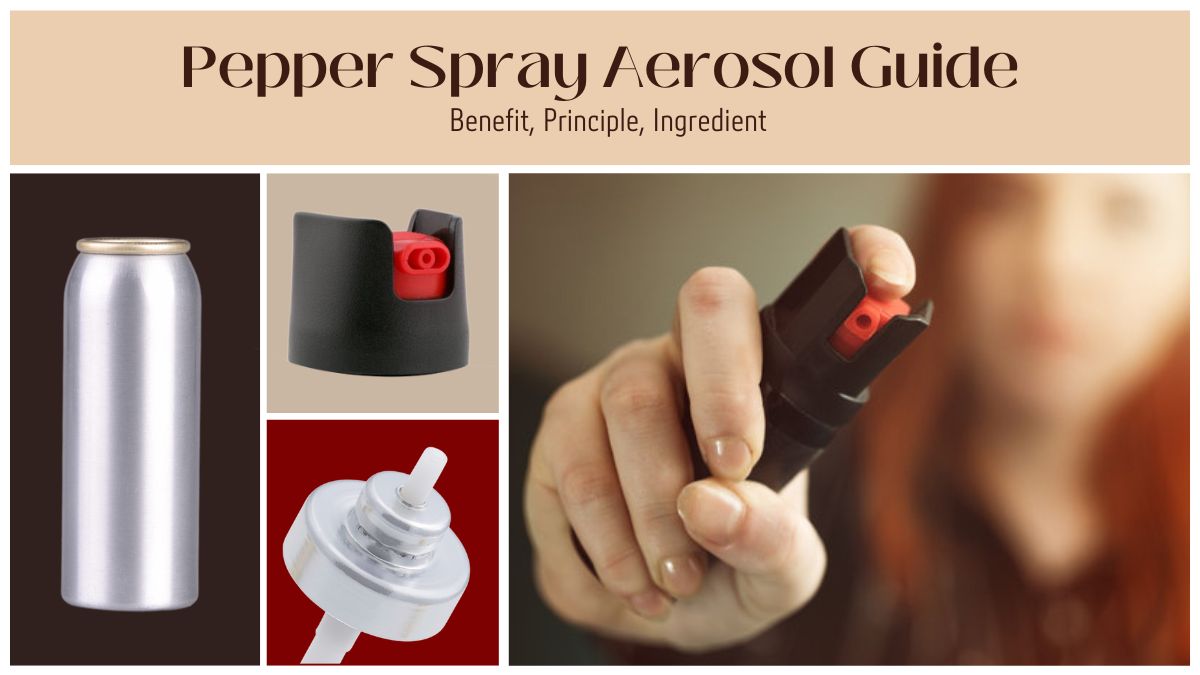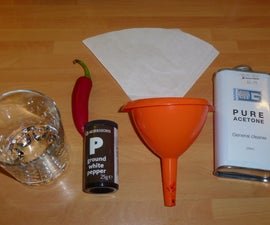When it comes to protecting yourself, understanding what’s inside your pepper spray is crucial. You might think pepper spray is just a simple spray, but the ingredients packed inside are carefully chosen to stop threats quickly and effectively.
Knowing these ingredients not only helps you trust your personal safety tool but also gives you insight into how it works on a chemical level. Are you curious about what makes pepper spray so powerful? Keep reading to discover the key components that turn ordinary peppers into a life-saving defense.
Your safety depends on knowing what’s in your spray—and this guide will reveal exactly that.

Credit: blog.fantasticservices.com
Key Ingredients
Pepper spray contains several key ingredients that make it effective for self-defense. Understanding these components helps explain how pepper spray works to deter attackers quickly. Each ingredient plays a specific role in the spray’s overall effect and safety.
Oleoresin Capsicum (oc)
Oleoresin Capsicum, or OC, is the main active ingredient in pepper spray. It is a natural extract from hot chili peppers. OC causes intense burning and irritation on the skin and eyes. This reaction temporarily disables an attacker, allowing the user to escape safely.
Capsaicinoids
Capsaicinoids are the chemical compounds in OC that create the burning sensation. Capsaicin is the most well-known capsaicinoid. These compounds affect nerve endings, causing pain and inflammation. The concentration of capsaicinoids determines the spray’s strength and effectiveness.
Carrier Agents
Carrier agents help deliver OC evenly when sprayed. Common carriers include water and oils. These agents keep the active ingredients stable and allow the spray to reach its target. They also help control the spray’s range and spread.
Additional Components
Other ingredients in pepper spray include preservatives and propellants. Preservatives keep the solution fresh and safe to use. Propellants, like compressed gases, push the spray out of the container. Some formulas may have dyes to mark an attacker for identification.
Extraction Process
The extraction process plays a key role in making effective pepper spray. This process involves removing the active compounds from peppers. The goal is to obtain a strong, pure substance that causes irritation. Each step in extraction ensures the spray works fast and reliably. Understanding these steps helps reveal how pepper spray ingredients come to life.
Source Peppers
The process starts with selecting the right peppers. Usually, hot chili peppers like cayenne or habanero are used. These peppers contain capsaicinoids, the chemicals that cause burning. Peppers are dried to preserve their strength before extraction begins. Quality peppers lead to a more potent spray.
Solvent Use
A solvent extracts the active compounds from peppers. Common solvents include alcohol or oil-based liquids. The solvent dissolves capsaicinoids, separating them from the pepper’s solid parts. This step ensures the spray contains the right ingredients in liquid form. The choice of solvent affects purity and strength.
Resin Concentration
The extracted liquid contains oleoresin capsicum (OC), a spicy resin from peppers. This resin is concentrated to increase effectiveness. Higher resin levels mean stronger irritation on contact. The concentration is carefully controlled for safety and power. This step defines the final product’s impact.
Emulsification
Oleoresin capsicum is oily and does not mix with water. Emulsification blends OC with water to create a stable spray. Emulsifiers help the oil spread evenly in the liquid. This process produces a smooth, consistent spray that works well. Emulsification ensures the spray delivers the active ingredient properly.
Active Compounds
Pepper spray’s power comes from its active compounds. These ingredients cause intense irritation to the eyes, skin, and respiratory system. The main active compounds come from natural substances found in hot peppers. Understanding these compounds helps explain how pepper spray works effectively for self-defense.
Capsaicin Role
Capsaicin is the key active compound in pepper spray. It triggers a burning sensation on contact. This compound irritates nerve endings in the eyes and skin. It causes immediate pain and temporary blindness. Capsaicin also inflames mucous membranes, making it hard to breathe. This reaction stops attackers quickly and safely.
Capsaicinoid Variations
Capsaicinoids are a group of related compounds. Capsaicin is the most abundant but not the only one. Others include dihydrocapsaicin and nordihydrocapsaicin. Each varies slightly in potency and effect. These variations influence how strong the pepper spray feels. Manufacturers adjust these to balance effectiveness and safety.
Concentration Effects
The concentration of capsaicinoids affects pepper spray’s strength. Higher concentrations cause more intense pain and inflammation. Lower concentrations may reduce effectiveness but increase safety. Most sprays use a balance to stop threats quickly without lasting harm. The concentration also affects how long symptoms last after exposure.
Differences From Tear Gas
Pepper spray and tear gas are both used for self-defense and crowd control. Their main difference lies in their active ingredients and how they affect the body. Understanding these differences helps in choosing the right protection tool.
Chloroacetophenone (cn)
Chloroacetophenone, or CN, is the active chemical in many tear gas formulas. It irritates the eyes, nose, and skin, causing tearing and discomfort. CN is less potent than pepper spray and works mainly as a mild irritant.
CN can cause burning, coughing, and temporary blindness. Its effects usually wear off quickly. This chemical was commonly used in older self-defense sprays but is less common today.
Effectiveness Comparison
Pepper spray contains oleoresin capsicum (OC), derived from hot peppers. OC causes intense burning and inflammation. It affects the eyes, skin, and respiratory system more strongly than CN.
OC causes temporary blindness and severe pain, making it highly effective for self-defense. CN may not stop aggressive individuals, especially if they are under drugs or alcohol influence.
Pepper spray acts faster and lasts longer, providing better protection. CN is milder and may require closer range for effectiveness.
Usage Scenarios
Tear gas with CN is often used by law enforcement for crowd control. It works on large groups, causing people to disperse. It is less suitable for personal self-defense due to its mild effects.
Pepper spray is designed mainly for personal protection. It is easy to carry and use in close encounters. It works well against attackers by causing strong pain and temporary blindness.
Choosing between CN tear gas and OC pepper spray depends on the situation. Personal safety favors pepper spray, while crowd control may use tear gas.
Formulation Variations
Pepper spray formulas vary depending on their intended use and brand. These differences affect how the spray works and how strong it is. Understanding the formulation variations helps users choose the right product for protection. The main ingredients and additives shape the spray’s effectiveness and safety.
Original Vs Modern Formulas
The original pepper spray used chloroacetophenone (CN), a tear gas chemical. CN causes mild irritation but can be less effective on some people. Modern formulas use oleoresin capsicum (OC), extracted from hot peppers. OC creates a stronger burning sensation and temporary blindness. This makes modern sprays more reliable in stopping threats quickly.
Brand-specific Ingredients
Different brands add unique ingredients to their sprays for better performance. Some use triple-filtered water to improve spray consistency. Others include stabilizers to extend shelf life. The concentration of OC also varies among brands. Higher concentrations produce a more intense effect but may cause more discomfort. Always check the label for exact ingredients.
Marker Dyes And Filters
Many pepper sprays contain marker dyes to identify attackers later. These dyes are visible under UV light and help law enforcement. Filters in sprays prevent clogging and ensure a steady stream. Some brands include ultraviolet marker dyes for better tracking. Marker dyes do not affect the spray’s power but add an extra safety feature.

Credit: www.cnshining.com
Health And Safety
Pepper spray is a self-defense tool made from natural and chemical ingredients. Knowing its health and safety aspects is vital. This helps users handle it properly and avoid harm. Understanding its effects and risks guides safe usage and protects your well-being.
Immediate Effects
Pepper spray causes a strong burning feeling on skin and eyes. It irritates mucous membranes, causing tears and difficulty seeing. Breathing becomes hard due to throat and nose inflammation. These reactions start within seconds after exposure. The effects usually last from 15 minutes to over an hour. They stop most attackers by causing intense pain and temporary blindness.
Exposure Risks
Direct contact with pepper spray can harm your eyes and skin. It may cause redness, swelling, and severe pain. Inhaling the spray can irritate lungs and cause coughing or shortness of breath. People with asthma or heart problems face higher risks. Prolonged exposure can worsen symptoms and require medical help. Accidental sprays or misuse put bystanders and pets at risk too.
Safe Usage Guidelines
Always keep pepper spray away from children and pets. Use it only in real emergencies for self-defense. Point the spray away from your face and others nearby. Test your spray occasionally to ensure it works well. Store it in a cool, dry place and check expiration dates. After using, rinse affected areas with water and seek medical help if needed. Follow local laws about carrying and using pepper spray.
Law Enforcement Use
Law enforcement agencies rely on pepper spray as a key tool for controlling aggressive suspects. The ingredients and formulations used affect its safety and effectiveness. Officers need a product that works quickly and stops threats with minimal harm.
Understanding the specific formulations and concentration levels is essential for proper use. These factors determine how well pepper spray performs in real situations. Below, we explore what law enforcement prefers and how these sprays meet strict standards.
Preferred Formulations
Most law enforcement pepper sprays use oleoresin capsicum (OC) as the active ingredient. OC comes from hot peppers and causes intense eye and skin irritation. Agencies choose OC for its reliable effect on stopping violent behavior.
Formulations often include purified water to help spray delivery. Some also add ultraviolet dye to mark suspects for later identification. These formulations balance effectiveness with safety for both officers and subjects.
Concentration Standards
Concentration of OC varies but usually stays between 0.18% and 1.33%. This range ensures strong impact without causing permanent injury. Agencies follow strict guidelines to keep sprays within safe limits.
Higher concentrations may increase pain but also risk more severe reactions. Law enforcement uses tested standards to maintain this balance. Proper concentration helps officers control situations without excessive force.
Effectiveness In The Field
Pepper spray quickly causes burning eyes, coughing, and breathing difficulty. These symptoms disable suspects long enough for officers to gain control. Effectiveness depends on spray accuracy and distance from the target.
OC sprays work well even if suspects resist or are under influence. The fast onset of effects helps reduce the need for physical struggle. Many departments report fewer injuries since adopting pepper spray as a standard tool.

Credit: www.zarc.com
Frequently Asked Questions
Is Pepper Spray Safe For Humans?
Pepper spray is generally safe for humans in self-defense but causes intense irritation, temporary blindness, and inflammation. Avoid direct or prolonged exposure.
What Is The Raw Material Of Pepper Spray?
The raw material of pepper spray is oleoresin capsicum (OC), extracted from dried hot peppers. It contains capsaicinoids causing irritation.
What Are The Ingredients In Mace Pepper Spray?
Mace pepper spray contains oleoresin capsicum (OC) from hot peppers, water, and sometimes an ultraviolet marker dye. Earlier formulas used chloroacetophenone (CN) tear gas. OC causes intense burning, temporary blindness, and inflammation, making it more effective for self-defense.
What Do Police Use For Pepper Spray?
Police use pepper spray made from oleoresin capsicum (OC), extracted from hot peppers. It causes intense burning, temporary blindness, and inflammation. Brands like SABRE Red contain high capsaicinoid concentrations, making them highly effective and widely used by law enforcement worldwide.
Conclusion
Understanding pepper spray ingredients helps you know how it works. The main component, oleoresin capsicum, comes from hot peppers. It causes strong irritation to eyes and skin, stopping threats quickly. Other ingredients like water and dyes make the spray safe and effective.
Knowing these details supports responsible and informed use. Always handle pepper spray carefully and store it properly. Safety is key when using any self-defense product. Stay aware and prepared to protect yourself if needed.







